Physical Address
304 North Cardinal St.
Dorchester Center, MA 02124
The cervix is the lower portion of the uterus which connects this organ to the vagina through the endocervical canal. It is divided into a portion that protrudes into the vagina (portio vaginalis) and one that lies above the vaginal vault (supravaginal portion) . The outer surface of the portio vaginalis is known as the exocervix or ectocervix, and the portion related to the endocervical canal corresponds to the endocervix. The opening of the endocervical canal onto the exocervix is known as the external os , whereas the grossly indistinct upper limit of the endocervical canal is designated the internal os .
Most of the exocervix is covered by nonkeratinizing squamous epithelium that in childbearing age is composed of three layers: basal cell, midzone (stratum spongiosum), and superficial. The portion of the midzone immediately above the basal layer is referred to as the suprabasal layer. The morphologic appearance of the various layers varies with age; in the postmenopausal period, the cells are atrophic and exhibit a high nuclear-to-cytoplasmic ratio. These changes should not be misinterpreted as evidence of squamous intraepithelial lesions (SILs)/cervical intraepithelial neoplasia (CIN).
Histochemically, the cells above the basal layer show variable amounts of glycogen, readily appreciated in sections with a periodic acid–Schiff (PAS) stain and clinically by the application of the iodine (Lugol or Schiller) test. Immunohistochemically, the cells of the basal layer are positive for low-molecular-weight keratin and tissue polypeptide antigen (TPA) but not for high-molecular-weight (epidermal type) keratin or for involucrin. The latter two markers become positive in the cells above the basal layer. Basal cells are also immunoreactive for estrogen receptors.
The glandular mucosa of the endocervix is formed by a layer of columnar mucus-secreting cells, the histochemical reactivity for the mucin depending on the time of the menstrual cycle. These cells rest on a normally inconspicuous layer of subcolumnar “reserve” cells, which are also positive for TPA. These “reserve” cells (in particular, those located at or near the squamocolumnar junction) are primarily involved in the processes of squamous metaplasia, high-grade squamous intraepithelial lesion (HSIL) (CIN2/3), and carcinoma. The glandular epithelium is immunoreactive for estrogen receptors. In addition to lining the surface, it invaginates into the stroma to produce elongated clefts (usually <5 mm deep but sometimes as deep as 1 cm or more), forming the endocervical glands.
The area where the squamous and glandular epithelia meet is known as the squamocolumnar junction ( Fig. 32.1 ). It should be noted that this junction is not located in the anatomic external os but rather in the adjacent exocervix, a fact that renders it easily accessible to the colposcope. The portion of endocervical mucosa covering the exocervix is sometimes referred to as ectropion and, inaccurately, as erosion . This is a very unstable region, in which replacement of one epithelium for another repeatedly occurs, a process that Robert Meyer allegorically referred to as “the fight of the epithelia.” Today, this area is more prosaically known as the transformation zone .
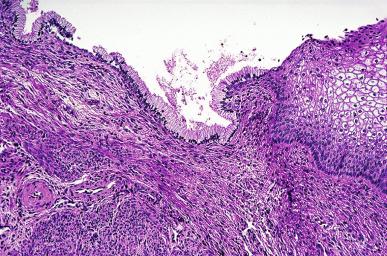
Scattered endocrine cells are found in both the normal endocervix and exocervix, and melanocytes are occasionally detected along the exocervical basal layer.
The stroma of the cervix is mainly made up of fibrous tissue admixed with elastic fibers and scattered smooth muscle fibers. It has a dominant CD34 immunophenotype, whereas the endometrial stroma has a dominant CD10 phenotype.
Mesonephric rests are remnants of the wolffian ducts that are found surrounded by the endocervical stroma in about a third of women. They are composed of tubules lined by a single row of cuboidal cells; they typically contain an inspissated deeply eosinophilic secretion in the lumen ( Fig. 32.2 ). They are immunoreactive for PAX8, PAX2, and GATA3, a fact potentially useful for their distinction from endocervical adenocarcinoma and other glandular proliferations of the cervix.
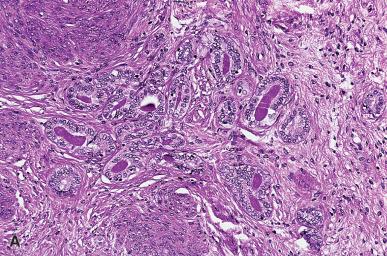
Ectopic tissues sometimes found in the cervix include cutaneous adnexa (sebaceous glands and hair follicles), prostatic tissue (sometimes referred to as “female prostate”), and mature cartilage islands . The latter (which may be metaplastic rather than ectopic) should not be confused with the cartilaginous component of a carcinoma or a rhabdomyosarcoma.
Various types of metaplastic change of the cervical epithelium occur, their appearance being related to the type of mucosa affected. Squamous metaplasia, by far the most common (to the point that some regard it as a normal finding) is centered on the transformation zone; transitional metaplasia involves the exocervical squamous epithelium; and tubal, tuboendometrial, and intestinal metaplasia affect the glandular epithelium of the endocervix.
The term squamous metaplasia is used to designate the focal or extensive replacement of the mucus-secreting glandular epithelium by stratified squamous epithelium, which, in its late stage, is morphologically indistinguishable from the epithelium normally lining the exocervical portion ( Fig. 32.3 ). The pathogenesis of this process, also known as prosoplasia , has been a subject of a heated controversy over the years. It is now generally agreed that it most commonly arises on the basis of proliferation and metaplasia of reserve cells. It is possible that in other instances it results from direct ingrowth of mature native squamous epithelium into the endocervical mucosa from the exocervix, possibly as a healing mechanism of a true cervical erosion. Strictly speaking, the latter is not a metaplastic process but rather one of “squamous epithelialization.” However, it is common usage to employ the term squamous metaplasia regardless of the presumed mechanism for the change.
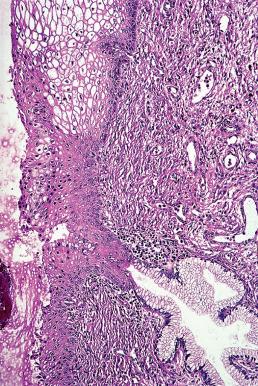
Some degree of squamous metaplasia is present in almost every uterine cervix during the childbearing years. Most commonly, the process involves only the superficial epithelium and is recognized by the presence of squamous epithelium overlying endocervical glands. In other instances, it involves the glandular component as well, resulting in a complex microscopic appearance that can be confused with invasive carcinoma by the inexperienced ( Fig. 32.4 ).
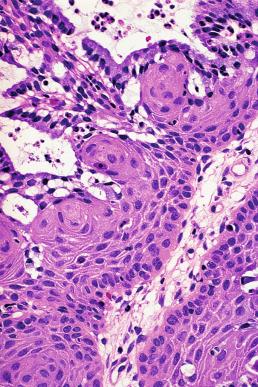
Ultrastructural and immunohistochemical markers of squamous epithelium appear pari passu with the morphologic changes. Variations on this theme, probably representing various stages within a continuum, have been described as reserve cell hyperplasia and as immature, intermediate , and mature squamous metaplasia . The presence of cytologic atypia in immature squamous metaplasia raises the possibility of SIL/CIN; p16 immunostaining can be used to establish a diagnosis of HSIL (CIN2/3), but there remains significant overlap in the morphologic features between atypical immature metaplasia and low-grade squamous intraepithelial lesion (LSIL), with resulting interobserver variability in distinguishing between these two possibilities. The diagnosis of SIL is discussed in more detail later in this chapter.
All of the above changes are characterized by a flat architecture and are, therefore, different from the condyloma and other papillary processes, including so-called papillary immature metaplasia (immature condyloma).
Although most cervical carcinomas arise in areas of the cervix that sometime in the past had been involved by squamous metaplasia, the latter process has no premalignant connotations per se. Actually, it is so common and insignificant that, unless quite extensive and/or involving the glandular component, we tend to ignore it altogether in our pathology reports.
A somewhat different appearance is seen often in the cervix of prolapsed uteri. The clinical appearance is usually referred to as “leukoplakic.” Microscopically, the process involves mainly the exocervical portion and is characterized by the appearance of granular and horny layers in the epithelium. This process, which is also unrelated to carcinoma, is best designated as keratosis . Sometimes this epithelium contains scattered large pale cells, a change that has been dignified by the term pagetoid dyskeratosis .
Transitional metaplasia is seen in the exocervix of older women, and it is often associated with atrophy. It morphologically resembles transitional (urothelial) epithelium, and it involves the entire thickness of the mucosa, without evidence of normal squamous maturation. The nuclei are oval and devoid of atypical features. Their long axes, which are arranged perpendicularly to the surface, often exhibit longitudinal grooves ( Fig. 32.5 ). Immunohistochemically, there is positivity for CK13, CK17, and CK18 but not for CK20. Its phenotypic profile is very similar to that of senile atrophy. Although this entity has engendered some controversy in the past, with respect to its relationship to SIL, it is now regarded as an entirely benign metaplastic change that differs from atrophy only in consisting of a greater number of cellular layers.
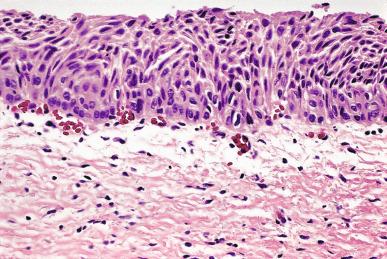
Tubal metaplasia is diagnosed when a specimen from the endocervix (usually from the upper portion) is found to contain all three cell types found in the normal fallopian tube (i.e., ciliated, secretory, and intercalated; Fig. 32.6 ). In many instances, the appearance of the metaplastic epithelium combines features of tubal and endometrial mucosa, in which case the term tuboendometrial (tuboendometrioid) metaplasia is employed. Diagnostic difficulties may result from the fact that these glands may be deeply seated, irregularly shaped, cystically dilated, and/or accompanied by a hypercellular, edematous, or myxoid stroma. The condition can be identified in cytologic preparations.
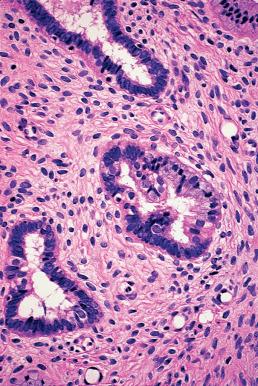
Combined staining for Ki-67 and p16 is of help in the differential diagnosis from in situ and invasive endocervical adenocarcinoma, as tubal metaplasia shows a lower proliferative index and lacks the strong, diffuse, block positivity for p16 seen in human papilloma virus (HPV)-associated adenocarcinomas. Tubal metaplasia is often found after conization, and it has therefore been suggested that it represents aberrant differentiation following injury.
A pseudoinvasive form of the condition has been described in women with a history of in utero diethylstilbestrol (DES) exposure, suggesting that it may be a form of DES-related adenosis.
Intestinal metaplasia is a vanishingly rare condition, which may be accompanied by extravasation of mucin into the stroma. The presence of goblet cells in the endocervix should prompt a search for dysplastic change/adenocarcinoma in situ; this may be HPV associated or HPV independent.
Oxyphilic (eosinophilic) metaplasia is characterized by the presence of large cuboidal or polygonal epithelial cells with dense eosinophilic, focally vacuolated cytoplasm and variable nuclear atypia in the endocervical glands. The differential diagnosis includes HSIL (CIN2/3) with eosinophilic cells, which can be recognized based on the presence of mitotic activity and p16 immunoreactivity.
Chronic cervicitis is an extremely common condition in adult females, at least at the microscopic level. It affects preferentially the squamocolumnar junction and endocervix, and it may be accompanied by hyperemia, edema, fibrosis, and metaplastic changes in the epithelium. The etiology is variable. In most cases the disease is asymptomatic. Given that the presence of inflammatory cells at the squamocolumnar junction is normal (this being the junction between the sterile endometrial cavity/endocervix and the exocervix/vagina), it is a highly subjective distinction between “normal cervix” and a degree of inflammation that merits designation as “chronic cervicitis.”
Herpes simplex infection of the cervix is now recognized as a relatively common occurrence. The microscopic appearance at the time of biopsy is usually that of an intense nonspecific inflammation with ulceration ( Fig. 32.7A ). Only rarely are diagnostic multinucleated squamous cells with intranuclear inclusions encountered (see Fig. 32.7B ). The diagnosis can be confirmed by immunocytochemical demonstration of the viral antigen.
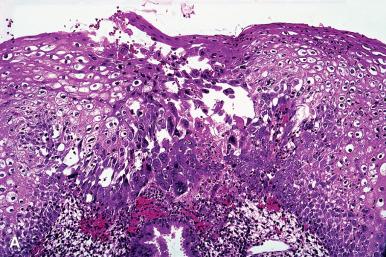
Chlamydia trachomatis infection is now recognized as the most common venereal disease in the Western world. The microscopic appearance in the cervix is that of a chronic nonspecific inflammation, with reactive epithelial atypia and sometimes prominent formation of lymphoid follicles. The organisms are not visible in routine histologic slides and only with difficulty in cytologic preparations, but they can be detected by immunocytochemical techniques. Culture isolation is regarded as the standard for diagnosis of active infection. Chlamydial cervicitis can be associated with CIN, but there is no evidence of a causal relationship.
Syphilis can affect the cervix, usually in the form of a primary chancre.
Amebiasis may produce a polypoid and ulcerated mass in the cervix clinically simulating carcinoma, and it may also engraft itself upon a preexisting cervical carcinoma.
Actinomycosis of the cervix occurs, but it needs to be distinguished from the more common pseudoactinomycotic radiate granules that may form around microorganisms or biologically inert substances.
Bilharziasis (schistosomiasis), common in Africa and Central America, can involve any portion of the female genital tract, including the cervix.
Malakoplakia occurs rarely in the cervix, sometimes in association with disease in the uterine corpus, renal pelvis, or kidney.
Ceroid granuloma of the type more commonly seen in the gallbladder has, exceptionally, been found to involve the cervix.
Localized arteritis of the cervix has been described, accompanied by inflammation and ulceration, and apparently restricted to this anatomic site. The cervix can also be involved in cases of granulomatosis with polyangiitis (formerly known as Wegener granulomatosis).
Endocervical polyps are not true neoplasms but are probably the result of chronic inflammatory changes (“chronic polypoid cervicitis”). They are usually small but may reach several centimeters in diameter. Microscopically, dilated endocervical glands are seen in an edematous, inflamed, and fibrotic stroma. HSIL (CIN2/3) is an occasional incidental finding in a polyp. Occasionally, the configuration of these polyps is that of a branching papillary structure, in which case the term papillary endocervicitis is employed ( Fig. 32.8 ). This lesion is to be distinguished from so-called superficial cervicovaginal myofibroblastoma, which is equally benign and perhaps histogenetically related. Exceptionally, cells with the morphology of signet ring cells are seen within an ulcerated endocervical polyp; they are probably the result of ischemia and should not be overdiagnosed as signet ring cell carcinoma.
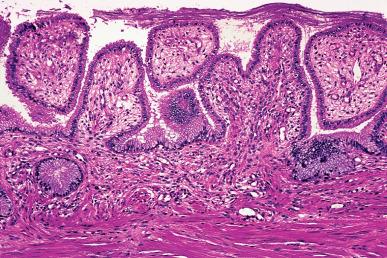
Nabothian cysts are thought to develop from blockage of the endocervical glands secondarily to inflammation and associated changes; they appear grossly as cystic spaces filled with mucoid material and microscopically as cystically dilated glands lined by a flattened epithelium, sometimes focally absent. Occasionally they extend deeply into the cervical wall, a phenomenon that should not be mistaken for malignancy.
Tunnel clusters, as originally described by Fluhmann, are the result of localized proliferation of endocervical glands (clefts), with side channels growing out from them. This may be accompanied by dilation resulting from the accumulation of inspissated, deeply eosinophilic secretion in the lumen ( Fig. 32.9 ).
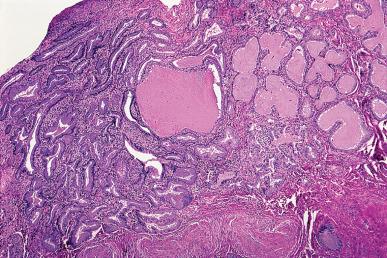
Microglandular hyperplasia of the endocervical epithelium was originally described in women using oral contraceptive drugs and, less frequently, during pregnancy. However, it can also be seen in the absence of these conditions and even in postmenopausal patients. The relationship between microglandular hyperplasia and oral contraception or other hormonal perturbations has been questioned. Microscopically, the typical case is characterized by a complex proliferation of small glands lined by flat epithelial cells with little or no atypia ( Fig. 32.10 ). The condition usually evolves into squamous metaplasia, resulting in a complex microscopic picture that may be confused with carcinoma ( Fig. 32.11 ). Additional features that may lead to overdiagnosis include areas of solid proliferation, pseudoinfiltrative pattern, signet ring cells, focal atypia, and occasional mitotic figures. The intervening stroma invariably shows chronic inflammation. There is usually no immunocytochemical reactivity for carcinoembryonic antigen (CEA), a useful feature in the differential diagnosis with endocervical adenocarcinoma. Microglandular hyperplasia must be distinguished from endometrial adenocarcinomas with microglandular hyperplasia-like features ; these carcinomas are seen in older patients, predominantly within the endometrial biopsy/curettings rather than the endocervical curettings, are often associated with atypical endometrial hyperplasia, and lack the p63 expressing reserve cells present in microglandular hyperplasia.
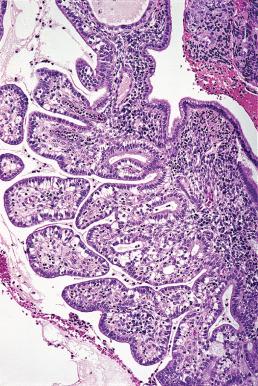
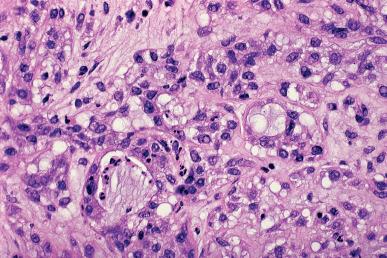
The Arias–Stella reaction, as seen during pregnancy, can involve the endocervical glands. The nuclear abnormalities are similar to those seen more commonly in the endometrial mucosa and should not be confused with malignancy. The microscopic appearance is quite variable and includes cells with vacuolated clear cytoplasm, intraglandular tufts, hobnail cells, oxyphilic cytoplasm, filiform papillae, nuclear pseudoinclusions, and cribriform intraglandular growth. In contrast to clear cell carcinoma, the Arias–Stella reaction does not form a mass lesion, lacks a desmoplastic stromal response, and does not have an infiltrative pattern.
Atypical reactive proliferation of the endocervical mucosal surface can be seen following endometrial sampling for endometrial carcinoma or other diseases. It shows nuclear stratification, short micropapillary processes, squamous metaplasia, hobnail cells, and mild cytologic atypia (i.e., many of the features that are associated with microglandular hyperplasia). It should not be interpreted as endocervical involvement by an endometrial carcinoma.
Diffuse laminar endocervical glandular hyperplasia (DLEGH) is a non-neoplastic condition characterized by a proliferation of medium-sized, evenly spaced, well-differentiated glands within the inner third of the cervical wall, sharply separated from the underlying stroma, and often accompanied by chronic inflammation ( Fig. 32.12 ) ; it should not be confused with adenoma malignum, from which it is distinguishable because of the fact that stromal infiltration, desmoplastic stromal response, and cytologic atypia are absent.
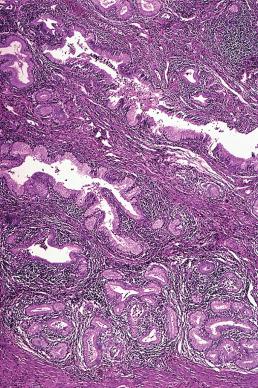
Lobular endocervical glandular hyperplasia (LEGH) is characterized by a distinctly lobular proliferation of small- to medium-sized glands, often centered around a larger central gland. The mucin secreted by some of these lesions is of gastric type. In contrast to adenoma malignum, LEGH lacks irregular stromal infiltration, desmoplastic stromal response, and significant cytologic atypia. Interestingly, the phenotype of this process is similar to that of pyloric glands. A possible pathogenetic relationship between the two conditions (and with HPV-independent mucinous adenocarcinomas of the cervix) has been suggested on the basis of some immunohistochemical and molecular genetic similarities, as well as their occasional association.
Mesonephric duct rests can undergo cystic dilation or be affected by florid and even atypical hyperplastic changes ( Fig. 32.13 ). This hyperplasia may have a lobular, diffuse, or ductal pattern ( Fig. 32.14 ). Rare malignant tumors arising from these structures also occur. Mesonephric remnants are also rarely involved by HSIL (CIN2/3). It is doubtful whether the rare benign polypoid lesion found in the cervix and vagina of young children and described as mesonephric papilloma is related to these remnants. Microscopically, it is a superficially located lesion composed of delicate connective tissue stalks covered by a layer of cuboidal cells and is probably of müllerian derivation.
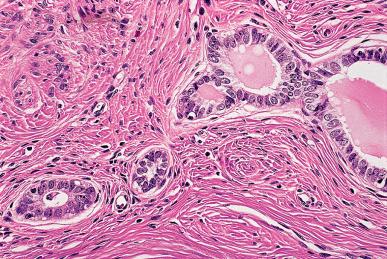
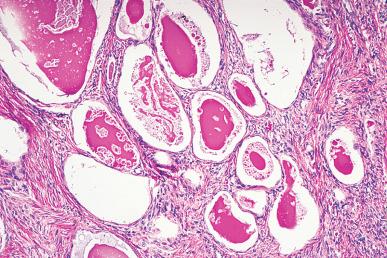
Multinucleated stromal giant cells can be present beneath the cervical epithelium and be mistaken for a malignancy. They are often accompanied by edema and may result in a vaguely polypoid-appearing lesion. These cells are of a reactive fibroblastic/myofibroblastic nature and analogous to those seen in other sites covered by mucosal membranes, such as vulva, vagina, anus, oral cavity, and nasal cavity.
Decidual reaction in the cervix during pregnancy usually presents as multiple, small, yellowish or red elevations of the cervical mucosa. They are soft and friable and bleed easily with trauma. Rarely, they develop into fungating masses difficult to distinguish grossly from carcinoma. Microscopically, the decidual cells are characterized by abundant pale granular cytoplasm and bland nuclei ( Fig. 32.15 ). Immunostains for keratin are negative.
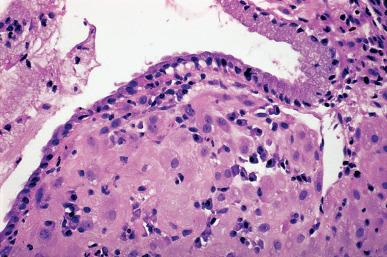
Placental site nodule appears as a well-defined hyalinized lesion located immediately beneath the mucosa. It is composed of intermediate trophoblasts exhibiting cytoplasmic vacuolization. Some nuclear atypia may be present. This lesion can be confused with carcinoma and with neoplastic cartilage. Immunohistochemically, the trophoblastic cells are reactive for keratin (another factor that may lead to a mistaken diagnosis of malignancy) but also for human placental lactogen.
Endometriosis of the cervix presents as blue or reddish nodules and may result in abnormal uterine bleeding. Both endometrial glands and stroma are needed to establish the diagnosis. However, the proportion of the two components may vary greatly from case to case. On occasion, the process is composed exclusively of endometrial stroma (“stromal endometriosis”) and may be confused with a neoplasm. Another source of confusion arises when the endometriosis is superficial, in which case it may be overinterpreted as endocervical glandular dysplasia or adenocarcinoma in situ, one of the reasons being that it may be mitotically active. It differs from tuboendometrial metaplasia of the endocervix because of the concomitant presence of endometrial-type stroma, however scarce. A lesion with an appearance resembling a miniature uterus in the cervix (“uterus-like mass”) has been interpreted as a form of superficial endometriosis with florid smooth muscle metaplasia. A bizarre variation on the theme is represented by endocervicosis , which can present as a deep-seated cervical mass simulating endocervical adenocarcinoma.
Necrobiotic granulomas resembling tuberculosis or rheumatoid nodules have been seen following cervical surgery. They are probably histologically and pathogenetically analogous to those described postoperatively in the prostate (see Chapter 26 ).
Florid mesenchymal reactions can develop from the cervical stroma as a result of various surgical interventions and lead to confusion with sarcoma. Some of these have a nodular fasciitis-like appearance and may be looked upon as the genitourinary equivalent of this soft tissue lesion.
Myxoid changes of probable degenerative nature can sometimes be seen in the cervical stroma (and in the myometrium) in the absence of any other pathology.
The role of HPV in the pathogenesis of both condyloma and carcinoma is so well established that it is easy to forget that relatively recently this relationship was completely unsuspected. It has now been demonstrated that greater than 99% of cervical carcinomas are associated with oncogenic HPV, and the molecular mechanisms of virus-mediated oncogenesis are understood in considerable detail. zur Hausen deservedly won the Nobel prize in 2008 for his work establishing the link between HPV and cervical cancer, and we now see the circle closing, with both primary HPV screening to detect premalignant lesions, and HPV immunization to prevent such lesions increasingly being adopted. Against that background we should acknowledge that this is a rapidly advancing field, and what you read in this section will undoubtedly be out of date prior to the next edition of this text. It is possible to envision a world where the burden of disease due to HPV is dramatically reduced, but that is years away, and for the foreseeable future we will be contending with biopsies and resection specimens where the diagnostic issue is the presence or absence of HPV-associated premalignant changes or malignancy. In the following section we will focus on the biology of HPV, so that we can relate it to histopathologic changes described later.
HPV is a DNA virus and is classified based on the viral genome into different genotypes, each designated by a number (e.g., HPV-6). HPV-2 is the most common cause of verruca vulgaris, but the focus of the following discussion are the genital HPV genotypes, transmitted by sexual contact and associated with either condyloma, in the case of the low-risk HPV genotypes such as 6 and 11, or cervical carcinoma, in the case of the high-risk genotypes (also referred to as oncogenic genotypes, later), of which HPV-16 and 18 are the most important. Other HPV genotypes considered to be oncogenic include 31, 33, 35, 39, 45, 51, 52, 56, 58, and 59. Other genotypes are considered to be possibly oncogenic, of uncertain oncogenic potential (i.e., insufficient information to classify), or non-oncogenic; HPV-6 and 11 are in the latter group. Among the oncogenic HPV genotypes, the risk varies, with some being more likely to be associated with malignant transformation.
The genital HPVs are epitheliotropic and the high-risk HPV types, in particular, have a tropism for the metaplastic squamous cells at the squamocolumnar junction. This has very important consequences for cytologic screening as most precursor lesions and carcinomas arise at this site, which is amenable to sampling with a brush or spatula. For example, if the lesions of HPV-associated neoplasia of the genital tract were randomly distributed within the squamous mucosa of the vagina and ectocervix, screening would have failed as it has in the oral cavity.
Potentially infectious virus particles must reach the proliferating basal cells for productive infection to take place, and it is thought that a micro-injury to the squamous epithelium is required for this to happen. In the case of glandular epithelium, in which there is a single layer of cells, the proliferating stem cell compartment should, in theory, be more accessible; however, it remains that infection of squamous cells is more likely than the cervical glandular epithelial cells for reasons that are not well understood. Once the virus particles are taken up by the basal epithelial cells the infection may become silent (e.g., through methylation of the viral genome, so that episomic viral DNA remains in the cell but is not transcribed or translated), or productive infection may result. Such an infection may result in orderly expression of viral genes as the host squamous cells mature, with assembly and release of infectious virus particles at the epithelial surface. This is typically associated with koilocytic change, a viral cytopathic effect in which the E4 protein encoded by the viral genome causes disruption in the cytoplasmic keratin matrix. The resulting koilocyte is a superficial or intermediate mature squamous cell characterized by a sharply outlined perinuclear vacuolation, dense- and irregular-staining peripheral cytoplasm, and an enlarged nucleus with an undulating (raisin- or prune-like) nuclear membrane and a rope-like chromatin pattern ( Fig. 32.16 ). Binucleation and multinucleation can occur. It is important that these nuclear changes—which may be accompanied by either a diploid or polyploid nuclear DNA distribution —be present somewhere in the lesion for the diagnosis of koilocytosis (and, by inference, HPV infection) to be made, or else other forms of cytoplasmic clearing (notably those related to glycogen accumulation) will be mistakenly included in this category. This orderly expression of the viral genome as the squamous cells mature and move to the surface results in LSIL, discussed in more detail later. There may also be, in the case of high-risk/oncogenic HPV infection, deregulated expression of the viral genome. The E6 and E7 proteins encoded by the genomes of these HPV genotypes bind and inactivate the proteins encoded by the TP53 and RB anti-oncogenes, resulting in unfettered proliferation of the host cell. This leads to decreased E4 expression and virion production, and decreased or absent koilocytic change, and increases the likelihood of integration of the viral genome into the host genome, acquisition of other genetic abnormalities in the host cell, and malignant transformation. Not all viral infections lead to transformation and most are cleared by the immune system of the host, through cell-mediated immunity.
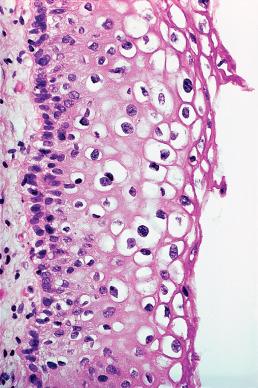
HPV can be detected by electron microscopy (as intranuclear crystalline and occasionally filamentous inclusions), but its specific identification depends on nucleic acid hybridization, which can be done with or without amplification, from DNA or RNA, in either a liquid-based or in situ analysis. Before talking about specific techniques for HPV detection, it is important to reiterate that the presence of HPV DNA may reflect (1) virus particles on the surface of the epithelium secondary to recent exposure, without infection, (2) productive infection that will be cleared completely by the host, (3) a latent infection, or (4) oncogenic HPV DNA that is integrated into the host genome. If the productive infection is by low-risk HPV (6 or 11), it leads to LSIL/condyloma, with viral cytopathic effects, while productive infection with high-risk HPV, most commonly 16 or 18, can lead to LSIL or can progress to HSIL or invasive squamous cell carcinoma. Thus identification of the specific genotype of HPV is of import, but even the identification of high-risk HPV does not mean that there is premalignant change or malignancy, and especially in the young, HPV may be cleared by the host. The Hybrid Capture HPV test, a signal-amplified hybridization microplate-based array designed to detect multiple HPV genotypes, is an example of a liquid based nucleic acid detection technique. These assays are the most sensitive, providing more sensitivity than in situ hybridization techniques. However, they can be too sensitive and may detect virus that has not infected the host or is in the process of being cleared by normal immune mechanisms. Critically for surgical pathology practice, p16 immunohistochemistry has emerged as a highly sensitive and specific surrogate test for infection by high-risk HPV. The p16 antioncogene is expressed at high levels in cells due to absence of the normal downregulation of p16 expression by phosphorylated RB protein; in cells infected by high-risk HPV this occurs through inactivation of the RB protein by the viral E7 protein. This results in high-level expression of p16, seen as strong nuclear and cytoplasmic immunoreactivity. There must be “block” positivity for p16 immunostaining to be indicative of high-risk HPV infection (i.e., strong nuclear and cytoplasmic staining of every cell in the basal third of the epithelium), with this staining typically extending into the middle and upper thirds. Correct interpretation of p16 immunostaining is only possible if the staining protocol has been properly validated, and appropriate controls run. There are a number of antibody clones specific for p16, and it is incumbent on each lab to optimize the staining for the clone they have chosen, a responsibility that is sometimes neglected. Immunoreactivity for p16 is not specific for HPV and other tumor types, unrelated to HPV, that have dysregulation of RB can show strong p16 staining (e.g., high-grade serous carcinoma of tubo-ovarian or endometrial origin). p16 expression can be lost through mutation, as cervical cancer progresses, but this appears to be rare in the in situ lesions of HSIL or in situ adenocarcinoma, so that p16 can serve as a very useful surrogate test for high-risk HPV in the cervix. The indications for use of p16 are covered in greater detail later in this chapter. Expression of the viral E5 oncoprotein mRNA is considered a better marker of HPV having a causative role in oncogenesis, in a given case (as HPV DNA may be present as a bystander if there is no transcription of the viral oncogenes), but such testing is currently not widely available in clinical laboratories.
We recommend use of the Bethesda terminology for cytology specimens and the diagnostic terminology proposed by the LAST committee, which is based on the Bethesda classification, for surgical pathology specimens. SIL terminology has gained wide acceptance, but there are still holdouts for the CIN terminology and we will adopt the practice, permitted under the LAST recommendations, of providing a two-part diagnosis, with SIL first and the equivalent CIN in parenthesis thereafter. LSIL will thus appear as “LSIL (CIN1).” CIN2 and CIN3 are both considered HSIL, and the distinction between CIN2 and CIN3 is arbitrary and not clinically relevant. Subtle differences in natural history have been reported for CIN2 versus CIN3, but we would attribute these to inclusion in the former group of some cases better classified as CIN1, rather than being an indication that CIN2 and CIN3 are distinct diseases. Accordingly, we will not make an effort to distinguish between CIN2 and CIN3, instead using the terminology HSIL (CIN2/3) for all high-grade lesions.
Most SIL are initially detected cytologically, which leads to colposcopic biopsy. Occasionally SIL will be an incidental finding, sometimes appearing in endometrial biopsy specimens. It is anticipated that there will be a decline in SIL with widespread HPV vaccination, but this has not impacted on practice yet. With primary HPV testing rather than cytologic screening, as discussed in the Cytology section later in this chapter, there will be more patients referred for colposcopic examination, so familiarity with SIL and its mimics will be important for those practicing general surgical pathology for the foreseeable future.
LSIL (CIN1) is inclusive of condyloma in the LAST criteria. The former practice of attempting to determine whether there is or is not dysplasia within condyloma (i.e., condyloma ± CIN1) has mercifully been brought to an end. Koilocytic viral cytopathic effect (see Fig. 32.16 ) is the pathognomonic feature of condyloma; it is doubtful whether LSIL (CIN1), as an indicator of HPV infection, can be reproducibly diagnosed in the absence of koilocytic change. Condyloma can be exophytic or flat. The former, condyloma acuminatum , are considerably less common than the latter and are visible grossly as a polypoid lesion characterized microscopically by papillomatosis, acanthosis, koilocytosis, and a variable degree of inflammatory infiltration of the stroma. An undulating appearance of the epithelium is a characteristic feature on low-power examination. A mild degree of atypia in the squamous component is common and need not be mentioned; if more severe, it should be evaluated and graded as for the flat SIL (i.e., is there HSIL [CIN2/3] present).
Condyloma acuminatum is associated with HPV-6 or HPV-11 in 70%–90% of the cases, but occasionally other types—such as HPV-16—are encountered. When the latter is the case, high-grade cytologic atypia may be found. The differential diagnosis of condyloma acuminatum includes verrucous carcinoma, discussed in more detail later. Inverted transitional cell (urothelial) papilloma , similar to its more common bladder counterpart, has been described in the cervix. It is probably not related to HPV and is included here only because it enters into the differential diagnosis with the other polypoid benign lesions of this region. Papillary transitional lesions can mimic condyloma acuminatum at low power, but there is no koilocytic change and the cells have very uniform nuclear features, with even chromatin and nuclear grooves. Squamous papilloma is the diagnosis that has been suggested for lesions that architecturally resemble condyloma acuminatum, are composed of benign squamous cells, without dysplasia, but lack koilocytic change. These may be related to condyloma but have cleared the HPV infection, but this is speculative. They are not considered to have premalignant potential.
Flat condyloma, so-called, is more commonly encountered than condyloma acuminatum, and is the classic lesion of LSIL (CIN1). It is typically not recognizable grossly. Microscopically, there is a relatively normal basal cell layer, expanded or hyperplastic parabasal cell layer, orderly maturation, mitotic activity confined to the lower third of the epithelium (but few or no abnormal mitoses), and koilocytosis ( Fig. 32.17 ). A degree of dysplasia of the lower third of the epithelium is acceptable within the spectrum of LSIL, although the distinction between “dysplasia” and reactive expansion of the parabasal layer due to increased proliferation is highly subjective. This lack of ability to distinguish between koilocytic change (HPV effect) with or without dysplasia contributed to them being combined as LSIL in the Bethesda classification. At this point we would most emphatically recommend that the old chestnut that mild, moderate, and severe cervical dysplasia (CIN1-3), respectively, are distinguished by dysplasia in the lower third, lower two thirds, and full thickness of the squamous epithelium be relegated to the bin reserved for medical trivia of historical interest only. This observation is still repeated to trainees and has no underlying mechanistic basis. The Bethesda classification reflects the biology of in situ squamous neoplasia of the cervix, especially as it relates to HPV, with a bipartite LSIL/HSIL system. The proliferation rate of LSIL (CIN1) is higher than that of inflamed or metaplastic cervical squamous epithelium. Most LSIL, apart from condyloma acuminatum, is associated with high-risk HPV types.
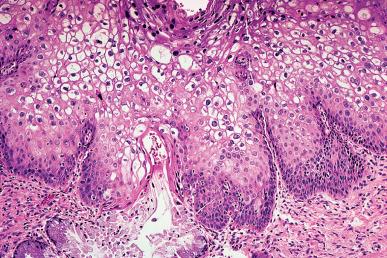
The natural history of LSIL is that most will clear spontaneously and relatively few will progress to HSIL (CIN2/3). Risk factors for progression include the presence of high-risk HPV, but, as noted previously, high-risk HPV are present in most LSIL. Cytokeratin 7, a marker of squamous cells of the transformation zone, has been proposed as a marker of LSIL that is more likely to progress. This is based on the observation that LSIL/condyloma can arise on the ectocervix or elsewhere in the lower female genital tract and at these other sites there is little risk of progression to HSIL. In contrast, the metaplastic squamous epithelium of the transformation zone is especially susceptible to progression when infected by high-risk HPV. CK7 is a marker of these metaplastic cells and, while it shows promise of being a marker of increased likelihood of progression from LSIL to HSIL, further validation is required before it enters routine practice.
HSIL (CIN2/3) may be seen macroscopically, when extensive ( Fig. 32.18 ), but is best appreciated colposcopically. On microscopic examination, it is characterized by a high N:C ratio in all layers of the epithelium, not just the basal and parabasal layers, but most importantly by striking nuclear atypia ( Fig. 32.19 ). There is prominent mitotic activity, with atypical mitoses typically present, and mitotic figures are found in the upper layers of the epithelium. There are cases where the differential diagnosis rests between LSIL and HSIL and the recommendation is that in such lesions p16 immunostaining be used as an adjunct; if there is strong and diffuse block positivity, a diagnosis of HSIL (CIN2/3) can be rendered. It is important to note that diagnosis of LSIL or HSIL is made primarily based on H&E, with use of p16 immunostaining only in selected borderline cases.
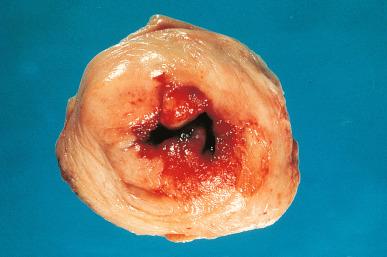
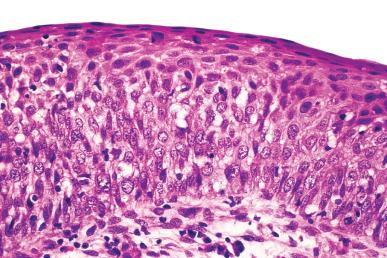
At a practical level, HSIL can be safely treated by conization, electrodiathermy, cryosurgery, laser, or loop electrosurgical excision, all of them done under colposcopic guidance. In making the final decision regarding the timing and type of therapy for this group of lesions, the microscopic diagnosis is only one of the factors to be considered, albeit a very important one. The extension of the lesion, age of the patient, parity, and the desire to have more children all have to be considered. Both the surface and the possible depth of involvement also have to be taken into account, as extension of HSIL (CIN2/3) into endocervical glands is common. ( Figs. 32.20 and 32.21 ) Anderson and Hartley calculated that destruction of tissue to a depth of 2.92 mm would eradicate all involved glands in 95% of the patients, whereas destruction to a depth of 3.8 mm would eradicate 99.7%. Positive margins and glandular involvement by HSIL (CIN2/3) are independent predictors of residual or recurrent disease.
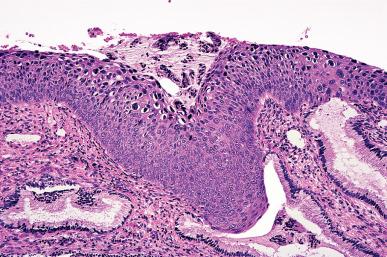
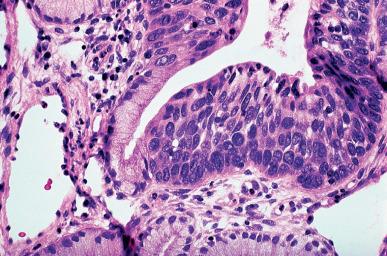
Once the pathologist has made the diagnosis of HSIL (CIN2/3) in a cervical biopsy, it is the responsibility of the gynecologist to determine the presence or absence of invasive carcinoma. Thorough cervical sampling and the proper sectioning of tissue should establish whether or not invasive carcinoma exists. If the latter is found, conventional methods of therapy may be instituted. Whenever the therapy is conservative, long-term follow-up (longer than 5 years) is imperative. In one series, patients with continuing abnormal cytology after initial treatment of HSIL (CIN2/3) were found to be 25 times more likely to develop invasive carcinomas than women with normal follow-up cytology.
The differential diagnosis of HSIL (CIN2/3) includes florid squamous metaplasia and transitional metaplasia. It should also be mentioned that the iodine test, used to delineate the extent of cervical disease prior to conization, can induce shrinkage, cytoplasmic eosinophilia and vacuolization, and pyknosis in the epithelial cells (particularly when they are abnormal to begin with).
Invasive squamous cell carcinomas in which the depth of stromal invasion is minimal (3 mm or less, and <7 mm in breadth, Stage Ia1) have been segregated from the others and designated as “superficial invasive carcinoma” ( Fig. 32.22 and Table 32.1 ).
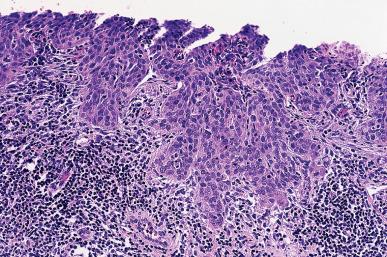
| Primary Tumor (T) | ||
| T CATEGORY | FIGO STAGE | T CRITERIA |
| TX | Primary tumor cannot be assessed | |
| T0 | No evidence of primary tumor | |
| T1 | I | Cervical carcinoma confined to the uterus (extension to corpus should be disregarded) |
| T1a | IA | Invasive carcinoma diagnosed only by microscopy. Stromal invasion with a maximum depth of 5.0 mm measured from the base of the epithelium and a horizontal spread of 7.0 mm or less. Vascular space involvement, venous or lymphatic, does not affect classification |
| T1a1 | IA1 | Measured stromal invasion of 3.0 mm or less in depth and 7.0 mm or less in horizontal spread |
| T1a2 | IA2 | Measured stromal invasion of more than 3.0 mm and not more than 5.0 mm, with a horizontal spread of 7.0 mm or less |
| T1b | IB | Clinically visible lesion confined to the cervix or microscopic lesion greater than T1a/IA2. Includes all macroscopically visible lesions, even those with superficial invasion. |
| T1b1 | IB1 | Clinically visible lesion 4.0 cm or less in greatest dimension |
| T1b2 | IB2 | Clinically visible lesion more than 4.0 cm in greatest dimension |
| T2 | II | Cervical carcinoma invading beyond the uterus but not to the pelvic wall or to lower third of the vagina |
| T2a | IIA | Tumor without parametrial invasion |
| T2a1 | IIA1 | Clinically visible lesion 4.0 cm or less in greatest dimension |
| T2a2 | IIA2 | Clinically visible lesion more than 4.0 cm in greatest dimension |
| T2b | IIB | Tumor with parametrial invasion |
| T3 | III | Tumor extending to the pelvic sidewall * and/or involving the lower third of the vagina and/or causing hydronephrosis or nonfunctioning kidney |
| T3a | IIIA | Tumor involving the lower third of the vagina but not extending to the pelvic wall |
| T3b | IIIB | Tumor extending to the pelvic wall and/or causing hydronephrosis or nonfunctioning kidney |
| T4 | IVA | Tumor invading the mucosa of the bladder or rectum and/or extending beyond the true pelvis (bullous edema is not sufficient to classify a tumor as T4) |
| Regional Lymph Node (N) | ||
| N CATEGORY | FIGO STAGE | N CRITERIA |
| NX | Regional lymph nodes cannot be assessed | |
| N0 | No regional lymph node metastasis | |
| N0(i+) | Isolated tumor cells in regional lymph node(s) no greater than 0.2 mm | |
| N1 | Regional lymph node metastasis | |
| Distant Metastasis (M) | ||
| M CATEGORY | FIGO STAGE | M CRITERIA |
| M0 | No distant metastasis | |
| M1 | IVB | Distant metastasis (including peritoneal spread or involvement of the supraclavicular, mediastinal, or distant lymph nodes; lung; liver; or bone) |
* The pelvic sidewall is defined as the muscle, fascia, neurovascular structures, and skeletal portions of the bony pelvis. On rectal examinations, there is no cancer-free space between the tumor and pelvic sidewall.
The justification for the recognition of this as a distinct entity is that the natural history of the lesion is quite different from that of ordinary invasive carcinoma and more akin to that of HSIL (CIN2/3). Accordingly, the treatment can be generally conservative, although it needs to be individualized. The common occurrence of pleomorphism, cellular differentiation, presence of conspicuous nucleoli, and individual cell keratinization in the areas of microinvasion has been emphasized ( Fig. 32.23 ). Since these features are rarely seen together in HSIL (CIN2/3), their presence in an apparently intraepidermal cervical lesion should stimulate the search for areas of invasion. Another feature that should raise the suspicion of early stromal invasion is the presence of a desmoplastic stroma rich in acid mucosubstances and characterized by metachromatic staining properties. In the area of invasion, there is a breach of the basement membrane. Hasumi et al. found that one (0.9%) of 106 patients with invasion up to 3 mm had lymph node metastases, whereas four (13.19%) of 29 patients with invasion of 3.1–5 mm had nodal metastases. This study served as the original basis for the definition of superficial invasion as 3 mm or less depth of invasion, with conservative surgery (as for HSIL [CIN2/3]) as treatment of choice, in contrast to the radical surgery, with parametrial and lymph node resection, used for more deeply invasive carcinomas.
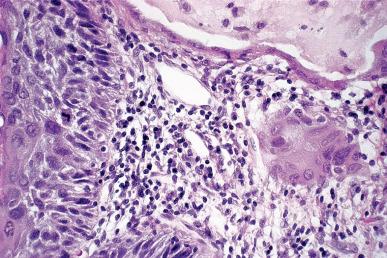
Become a Clinical Tree membership for Full access and enjoy Unlimited articles
If you are a member. Log in here